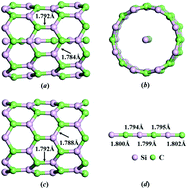Structural and electronic transport properties of a SiC chain encapsulated inside a SiC nanotube: first-principles study
Abstract
Silicon carbide (SiC) chains and silicon carbide nanotubes (SiCNTs), as promising one-dimensional nanostructures, have potential applications in more controllable nanoelectronic devices. In this paper, we design a completely new hybrid structure with encapsulation of a linear SiC chain inside a SiCNT, using first-principles calculation and the non-equilibrium Green's function formalism to systematically investigate the structural stability and electronic properties, particularly the quantum transport properties. It is found that, due to the nanotube–chain interaction, the stability of this structure is mainly provided by the charge transfer from the hosting tube to the guest chain. Furthermore, the transport properties of the hybrid structure confirm that encapsulation of a SiC chain within a SiCNT can significantly enhance the electronic transport of the component system in a wide range of high voltage. The distance and the unique coupling configuration between the encapsulated system and the electrodes are demonstrated to be other important factors that affect the transport behaviours. We hope that our study of encapsulation may offer a significant starting point for the design of new materials related to low-dimensional SiC nanostructures and possibly open a novel path towards stability and conductivity enhancement.

- This article is part of the themed collection: 2019 PCCP HOT Articles


 Please wait while we load your content...
Please wait while we load your content...